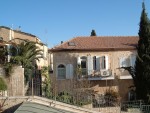Jerusalem has been known as the Eternal City of the Jewish people since the days of King David and his son Solomon. (photo by Cynthia Ramsay)
My daily routine probably doesn’t differ much from yours. This morning, I went for an early morning walk, and enjoyed the pearly dawn before the sun broke through the clouds. Then I went to a local grocery store and bought some fresh bread for breakfast, before my workday began. Trivial, mundane things. The only difference is my day took place in Jerusalem.
This fact adds an extra dimension to all of my activities. Jerusalem has been known as the Eternal City of the Jewish people since the days of King David and his son Solomon. Even today, generation after generation continues to pray, “If I forget thee, O Jerusalem, may my right hand lose its cunning.” This line was sung under the chuppa at a wedding I recently attended. Jews turn towards Jerusalem as the focus of their longing three times a day in prayer – no matter in what part of the world they live.
The city’s history is long. Five thousand years ago, a group of settlers chose to make their homes on the steep ridge called the Ophel, south of the Old City. In 2000 BCE, Abraham and Isaac ascended Mount Moriah; a thousand years later, King David captured the city, bringing the Holy Ark to Jerusalem, and establishing its sanctity for the Jewish people. From the years 961-922 BCE, King Solomon constructed the First Temple. In 537 BCE, the Jews returned from their exile in Babylon and, in 517 BCE, completed the building of the Second Temple. Then the Greeks, under Alexander the Great, took the city. Antiochus ruled, desecrating the Temple until the Maccabees liberated it. In 63 BCE, Pompey the Great captured it and, for 33 years, King Herod reconstructed the Second Temple. That’s 4,000 years of Jewish history!
Jerusalem’s history continued to be a story of conquest and destruction by an endless chain of occupiers lusting for this precious jewel … the Romans, the Greeks, the Crusaders, Egyptian Mamluks, the Ottoman Empire, the British Mandate, the Jordanians, all lusting for this battle-worn city that possesses no material riches, neither gold nor precious metals, no minerals, no oil, nothing to enrich their coffers.
I don’t know why, although many have tried to come up with some reasons. Jews and non-Jews alike have felt Jerusalem’s magnetism across the ages. Midrash Tehillim 91:7 tells us, “Praying in Jerusalem is like praying before the Throne of Glory, for the gate of heaven is there.” In his 1950 book Jerusalem Has Many Faces, Judah Stampfer wrote: “I have seen a city chiseled out of moonlight, its buildings beautiful as silver foothills, while universes shimmered in its corners.”
I have had the opportunity to visit many enchanting cities, including Venice, Avignon, Bruges, Hong Kong, Paris; all have a magic that transforms the senses. Yet, I can’t define the magnetism of Jerusalem. Certainly there are cities that exceed it in beauty and dignity. Perhaps we can think of Jerusalem as more an emotion than a city. It arouses passions, it nurtures the soul, it is spiritual and inspiring.
To call it home for the past 44 years is, for me, an enormous privilege. I am always aware of the history under my feet. I never forget the nameless heroes who fought to retain it for the Jewish people. Not just in long-ago history, but also those who fought to reunite the city in 1967’s Six Day War. So many heroes who gave their lives so that I, and thousands of ordinary people just like me, could live out our lives in the Eternal City.
Dvora Waysman is the author of 13 books. She can be contacted at ways@netvision.net.il or through her blog dvorawaysman.com.

